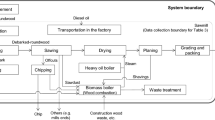Abstract
As one of the main structural units in a building, a solid wood floor has significant strategic research value for low-carbon energy saving. Taking the production line of a solid larch wood floor as a case study, we assessed the environmental load during production based upon a life cycle assessment. Using GaBi 6.0 software, we analyzed the associated carbon sequestration during floor production, with the initial planting density serving as the disturbance factor in a modular analysis. The results indicated that the cutting and finishing steps have relatively intense, negative influences on the environment, whereas transportation, ripping, and trimming do not. Additionally, recycling biomass waste has the potential to reduce greenhouse gas emissions. When the initial planting density was 3.0 × 3.0 m, carbon sequestration was relatively high. Although the emissions of freshwater pollutants, volatile organic compounds, and fine particulate matter (matter with a 2.5-μm diameter) were comparatively high, the reduction of greenhouse gas emissions was still excellent at this planting density.




Similar content being viewed by others
References
Antonova GF, Stasova VV (1997) Effects of environmental factors on wood formation in larch (Larix sibirica Ldb) stems. Trees 11(8):462–468
Begg K, Parkinson S, Wilkinson R (2001) Maximizing GHG emissions reduction and sustainable development aspects in the clean development mechanism. World Resour Rev 13:315–334
Fredrik H, Christian A (2009) Bioenergy plantations or long-term carbon sinks?—a model based analysis. Biomass Bioenergy 33(12):1693–1702
Guinée JB (2002) Life cycle assessment: an operational guide to the ISO standards. Kluwer Academic Publishers, Dordrecht, pp 1–273
Guo MH (1996) A study on the relationship of cultivation measures and wood properties of red pine plantation. PhD Thesis, Northeast Forestry University, Harbin, p 12–32
He YJ, Qin L, Li ZY, Shao MX, Liang XY, Tan L, Feng ZW (2012) Carbon storage capacity of a Betula alnoides stand and a mixed Betula alnoides × Castanopsis hystrix stand in Southern Subtropical China: a comparison study. Acta Ecol Sin 32:7586–7594
Houghton RA, Skole DL (2000) Annual fluxes of carbon from deforestation and regrowth in the Brazlian Amazon. Nature 403(6767):301–304
IPCC Climate Change (2013) Mitigation of climate change of working groups III to the fifth assessment report of the intergovernmental panel on climate change. Cambridge University Press, Cambridge, pp 1–65
Li SL (2006) Study on forest carbon sequestration. Northeast Forestry University Press, Harbin, pp 22–34
Ma W, Sun YJ, Guo XY, Ju WZ, Mu JS (2010) Carbon storage of Larix olgensis plantation at different stand ages. Acta Ecol Sin 30(17):4659–4667
Nair AB, Sivasubramanian P, Balakrishnan P, Kumar KANA, Sreekala MS (2013) Environmental effects, biodegradation, and life cycle analysis of fully biodegradable “green” composites. In: Thomas S, Joseph SK, Malhotra K, Goda K, Sreekala MS (eds) Polymer composite. Wiley, Weinheim, pp 515–568
Nebel B, Zimmer B, Wegener G (2006) Life cycle assessment of wood floor coverings. Int J Life Cycle Assess 11(3):172–182
Olson KR, Al-Kaisi MM (2015) The importance of soil sampling depth for accurate account of soil organic carbon sequestration, storage, retention and loss. CATENA 125:33–37
Post WM, Emanuel WR, Zinke PJ, Stangenberger AG (1982) Soil carbon pools and world life zones. Nature 298(5870):156–159
Primo P, Paolo S, Antonio B, Luana I, Luigi N, Luca R, Francesco P, Umberto D, Stefania P (2016) Assessment of carbon balance in intensive and extensive tree cultivation systems for oak, olive, poplar and walnut plantation. J Clean Prod 112(4):2613–2624
Puettmann ME, Wilson JB (2005) Life-cycle analysis of wood products: cradle-to-gate LCI of residential wood building materials. Wood Fiber Sci 37:18–29
Wu ZH (2015) Relation analysis of the life cycle and carbon sequestration of wood. Furniture 36(1–6):43
Zhang XQ, Wu SH, He Y, Hou ZH (2005) Forests and forestry activities in relations to emission mitigation and sink enhancement. Sci Silvae Sin 41(6):150–156
Author information
Authors and Affiliations
Corresponding author
Additional information
Project funding: This study is supported by the Science and Technology Support Project for the Twelfth Five-year Grant in China (Grant No. 2015BAD14B05).
The online version is available at http://www.springerlink.com
Corresponding editor: Zhu Hong.
Rights and permissions
About this article
Cite this article
Hu, S., Guan, X., Guo, M. et al. Environmental load of solid wood floor production from larch grown at different planting densities based on a life cycle assessment. J. For. Res. 29, 1443–1448 (2018). https://doi.org/10.1007/s11676-017-0529-x
Received:
Accepted:
Published:
Issue Date:
DOI: https://doi.org/10.1007/s11676-017-0529-x




